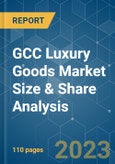Key Highlights
- Long-term growth in the GCC luxury goods industry is anticipated due to rising disposable income, a growing millennial population, rising tourism, and the penetration of international market players in the area. Customer's attention is being drawn by the introduction of products in the market by major players on the international scene, including Gucci, LMVH, PVH, and Rolex.
- For instance, in April 2022, the Alshaya franchise group's fash-leisure clothing brand Tribe of 6 debuted in Kuwait, the Kingdom of Saudi Arabia, and the United Arab Emirates. The brand promotes diversity and body positivity by offering various items, such as unisex styles in a range of sizes.
- Apart from this, the establishment of upscale malls has also offered these brands ample space to expand their operations in the country. Moreover, social media and the trend of online shopping have positively influenced the luxury footwear market in Saudi Arabia since shoppers may now access luxury brands through online platforms.
- In 2021, a collaboration between Adidas Originals and designer Arwa Al Banawi resulted in the launch of a highly personalized version of the iconic forum silhouette. These new sneakers, appropriately designed in sand tones, were called the Adidas Originals by Arwa Al Banawi Forum Lo Sneaker. They were made available for sale through an exclusive early-access virtual release at a prominent location on the Saudi Arabian tourist map on May 25. The sneakers quickly sold out, reflecting their popularity among consumers.
- The emergence of e-commerce has provided consumers with easy access to product-related information and prices through online sources. This factor has further contributed to the overall growth of the luxury goods market. Consumers in the GCC are highly conscious of their luxury cosmetics and fragrances choices. Hence, the companies operating in the market are working to enhance their sustainable packaging styles.
GCC Luxury Goods Market Trends
Increasing Use of E-commerce Platform for Buying Luxury Goods
- The GCC online retail market is growing fast and is drawing massive attention from investors across the globe. Bahrain, United Arab Emirates, and Qatar have the highest internet penetration rates in the world at present. The rapid growth was fueled by improved product range, ease of buying, customer choice of delivery date, and a smooth purchasing experience. Luxury fashion has developed itself in the digital world.
- Also, the rise in Internet use has led to consumers' exposure to various luxury goods, which is expected to propel the market during the forecast period. As per the World Bank data, the percentage of the population using the Internet across Saudi Arabia reached 100% in 2021.
- Consumers now engage with most brands through their online stores and multi-brand e-tailers. About half of the luxury goods buyers are now swayed by what they hear or watch online. From Louis Vuitton to Chanel and Gucci, luxury fashion houses have been rushing to embrace digital, whether by partnerships with multi-brand sites like Farfetch, creating their websites, or combining the two.
- The shift to digital makes sense as online purchases are projected to fuel potential luxury goods demand growth. As a result, sales of brick-and-mortar retailers will decline. Some well-known online stores offering luxury products across the market include Tutus Kurniati, Goshopia, The Luxury Closet, Ounass, Tryano, Farfetch United Arab Emirates, Bloomingdale’s, and Elilhaam.
United Arab Emirates as the Regional Hub for Luxury Shopping in the GCC
- Dubai has continued to be the key regional hub for purchasing luxury goods and has stood out as a leader in retail space quality. Also, other cities in the United Arab Emirates have risen in their rankings in terms of the cost of living. The United Arab Emirates has always been an attractive location for ex-pats. Due to the highly competitive compensation packages, falling real estate prices, high safety standards, and a healthy economy, it continues to be so. Dubai and Abu Dhabi feature among the top 10 cities globally in terms of the new retail space under construction.
- The rise in the number of tourists across the region also drives the United Arab Emirates luxury market. Dubai rose in popularity as a travel destination for Indian tourists in 2022. As per the Government of Dubai's data published by the Dubai Statistics Center, Dubai welcomed more than 500,000 Indian tourists to the city in 2022.
- In contrast to other years, fewer foreign visitors, or about eight million individuals, arrived in the United Arab Emirates in 2020. However, as more people traveled in 2021, the tourism sector has been progressively regaining strength. Hence, the rise in tourism across the nation is also expected to boost the demand for luxury goods across the region.
GCC Luxury Goods Industry Overview
The GCC luxury goods market is highly competitive, with global and domestic players. The key players in the market studied are Prada S.p.A., Kering Group, Rolex SA, LVMH Moët Hennessy Louis Vuitton and Capri Holding. However, other players like Chanel, Burberry Group Plc, and others show dominance over the market.The strategies majorly adopted by the top luxury goods companies across the region include expansion and product innovations. Companies in the market have been competing on different factors, including product offerings, quality, sustainable packaging, marketing, and brand omnichannel activities, to gain a competitive advantage in the market and expand their business. The emergence of e-commerce further contributed to the overall growth of the Gulf Cooperation Council luxury goods market.
Additional Benefits:
- The market estimate (ME) sheet in Excel format
- 3 months of analyst support
Table of Contents
Companies Mentioned (Partial List)
A selection of companies mentioned in this report includes, but is not limited to:
- Chanel Limited
- Etoile Group
- LVMH Moët Hennessy Louis Vuitton
- Rolex SA
- Alshaya Franchise Group
- Prada S.p.A.
- Dolce & Gabbana Luxembourg S.À R.L.
- Kering SA
- Burberry Group PLC
- AW Rostamani Group
- Capri Holdings










